Selection of TCC Curve and Protection Cooperation Method of Distribution Line Using Linear Optimization
Abstract
:1. Introduction
2. TCC Selection and Analysis for Constraints on Protective Devices
2.1. Analysis of Time Difference between Protection Cooperation between Devices
2.2. Distribution Line Measurement Error and Fault Current Range Analysis
- (A)
- measurement error within the rated value (600 A),
- (B)
- measurement error up to 20 times the rated value (12,000 A),
- (C)
- Apply by adding a design margin of in the (B) to ensure stable and safe operation in the high current area.
2.3. TDS Range Selection for Substation Relay
2.4. Selection of Adequate Pick-Up Current of Protective Device
2.5. Minimum Unit Selection of TDS and MRT
3. Optimal Protection Coordination and Standardization Methods
3.1. Objective Function of TDS
3.2. Linear Optimization of TDS with Overhead Line Distribution Model Simulation
3.3. Protection Cooperation Method Using Proposed TDS and MRT
4. Analysis of Actual Distribution Line Application Results
5. Conclusions
Author Contributions
Funding
Conflicts of Interest
References
- Korea Electric Power Corporation Department of Distribution System. Distribution Operating Facility Statistics; Korea Electric Power Corporation Department of Distribution System: Daejeon, Republic of Korea, 2019.
- Yun, S.-Y.; Chu, C.M.; Kwon, S.C.; Song, I.K.; Choi, J.H. The development and empirical evaluation of the Korean smart distribution management system. Energies 2014, 7, 1332–1362. [Google Scholar] [CrossRef] [Green Version]
- Liao, Y. Generalized fault-location methods for overhead electric distribution systems. IEEE Trans. PWRD 2011, 26, 53–64. [Google Scholar] [CrossRef]
- Ustun, T.S. Design and Development of a Communication-Assisted Microgrid Protection System. Ph.D. Thesis, Victoria University, Melbourne, VIC, Australia, September 2013. [Google Scholar]
- Shaikh, M.F.; Katyara, S.; Khand, Z.H.; Ali Shah, M.; Staszewski, L.; Bhan, V.; Majeed, A.; Shaikh, S.; Zbigniew, L. Novel protection coordination scheme for active distribution networks. Electronics 2021, 10, 2312. [Google Scholar] [CrossRef]
- Bo, Z.Q.; Lin, X.N.; Wang, Q.P.; Yi, Y.H.; Zhou, F.Q. Developments of power system protection and control. Prot. Control Mod. Power Syst. 2016, 1, 1–8. [Google Scholar] [CrossRef] [Green Version]
- Kersting, W.H. Distribution System Modeling and Analysis, 2nd ed.; CRC Press: Boca Raton, FL, USA, 2007; pp. 53–89. [Google Scholar]
- Saadat, H. Power System Analysis; McGraw Hill: New York, NY, USA, 2002; pp. 203–234. [Google Scholar]
- Naiem, A.F.; Hegazy, Y.; Abdelaziz, Y.; Elsharkawy, M.A. A Classification Technique for Recloser-Fuse Coordination in Distribution Systems with Distributed Generation. IEEE Trans. Power Deliv. 2012, 27, 176–185. [Google Scholar] [CrossRef]
- Chaitusaney, S.; Yokoyama, A. Reliability Analysis of Distribution System with Distributed Generation Considering Loss of Protection Coordination. In Proceedings of the Conference on Probabilistic Methods Applied to Power Systems, Stockholm, Sweden, 11–15 June 2006. [Google Scholar]
- Abdelaziz, A.Y.; Talaat, H.E.A.; Nosseir, A.I.; Hajjar, A.A. An adaptive protection scheme for optimal coordination of overcurrent relays. Electr. Power Syst. Res. 2002, 61, 1–9. [Google Scholar] [CrossRef]
- Muda, H.; Jena, P. Sequence Currents based Adaptive Protection Approach for DNs with Distributed Energy Resources. IET Gener. Transm. Distrib. 2017, 11, 154–165. [Google Scholar] [CrossRef]
- Shih, M.Y.; Conde, A.; Leonowicz, Z.; Martirano, L. An Adaptive Overcurrent Coordination Scheme to Improve Relay Sensitivity and Overcome Drawbacks due to Distributed Generation in Smart Grids. IEEE Trans. Ind. Appl. 2017, 53, 5217–5228. [Google Scholar] [CrossRef] [Green Version]
- Korea Electric Power Corporation Department of Distribution System. Distribution Protection Statement; Korea Electric Power Corporation Department of Distribution System: Daejeon, Republic of Korea, 1995.
- IEC Standards 60056; High-Voltage Alternating-Current Circuit Breaker. IEC: Geneva, Switzerland, 2001.
- IEC Standards 61869-2; Part 2: Additional Requirements for Current Transformers. IEC: Geneva, Switzerland, 2001.
- IEEE Std 242-2001; IEEE Recommended Practice for Protection and Coordination of Industrial and Commercial Power Systems (IEEE Buff Book). IEEE: Piscataway, NJ, USA, 2001; pp. 1–710.
- IEEE Std C37.230-2020; IEEE Guide for Protective Relay Applications to Distribution Lines. IEEE: Piscataway, NJ, USA, 2021; pp. 1–100.
- Cho, N.; Kim, J.; Kim, G. A Study on the Standard CB Ry Protection Coordination of KEPCO Distribution Systems; The Korean Institute of Electrical Engineers Conference on Electrical Engineering: Seoul, Republic of Korea, 2019. [Google Scholar]
- IEEE C37.112-1996; Power System Relaying and Control Committee. IEEE Standard Inverse-Time Characteristic Equations for Overcurrent Relays. IEEE: Piscataway, NJ, USA, 2005; pp. 1–19.
- Chabanloo, R.M.; Abyaneh, H.A.; Kamangar, S.S.H.; Razavi, F. Optimal combined overcurrent and distance relays coordination incorporating intelligent overcurrent relays characteristic selection. IEEE Trans. Power Deliv. 2011, 26, 1381–1391. [Google Scholar] [CrossRef]
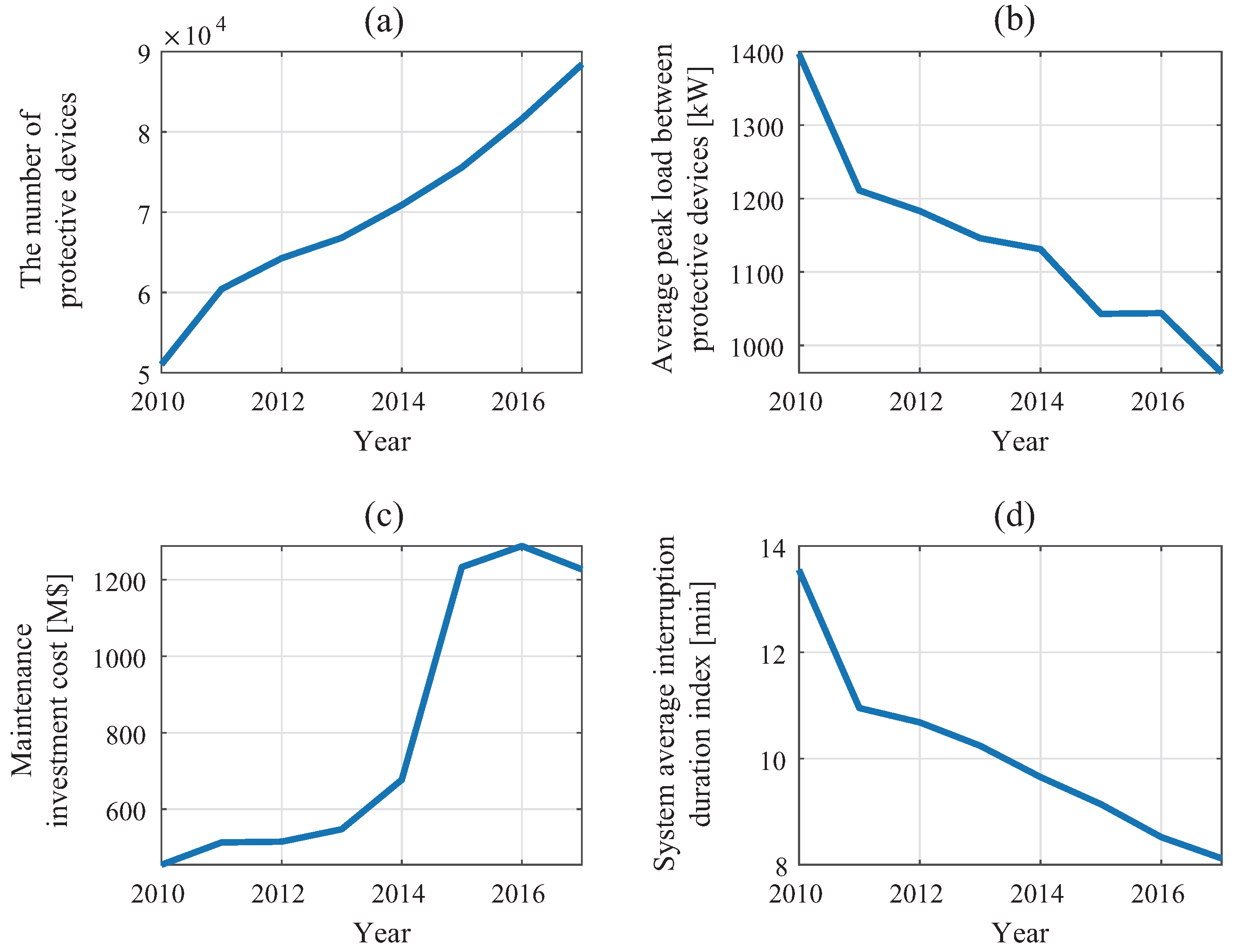
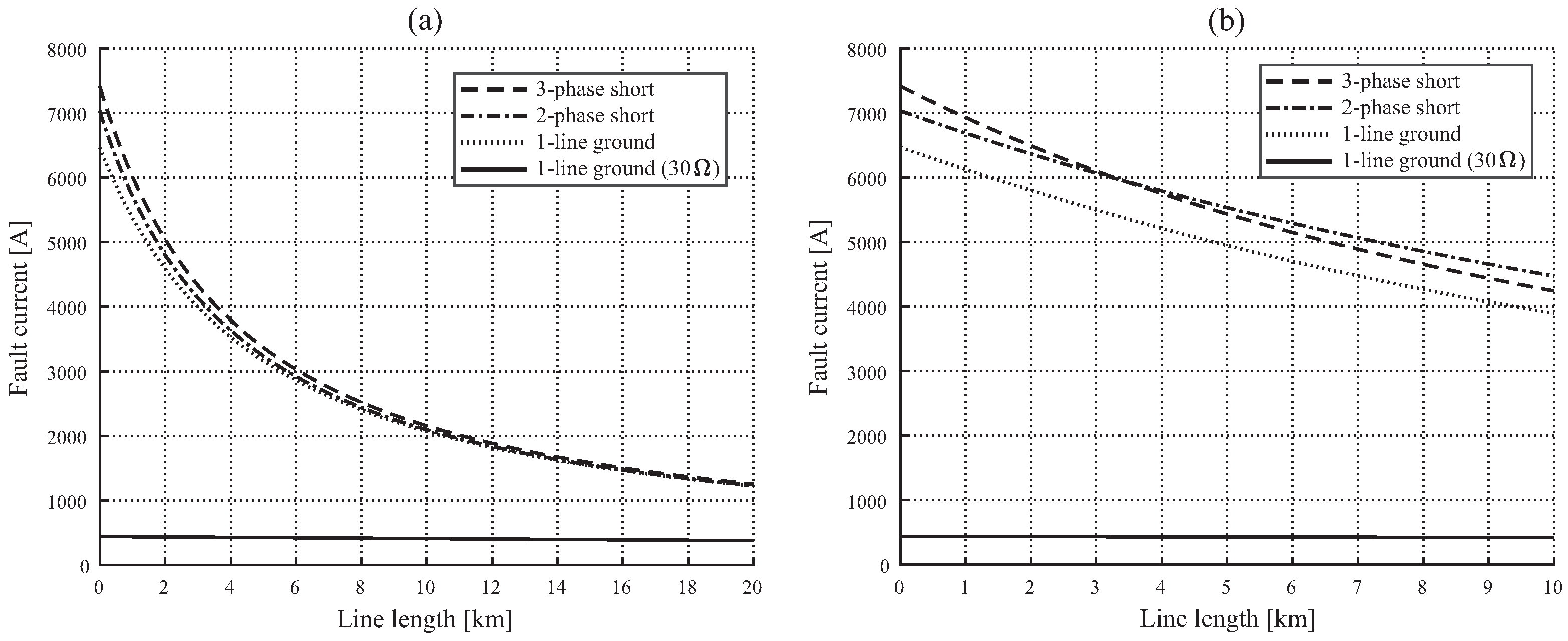
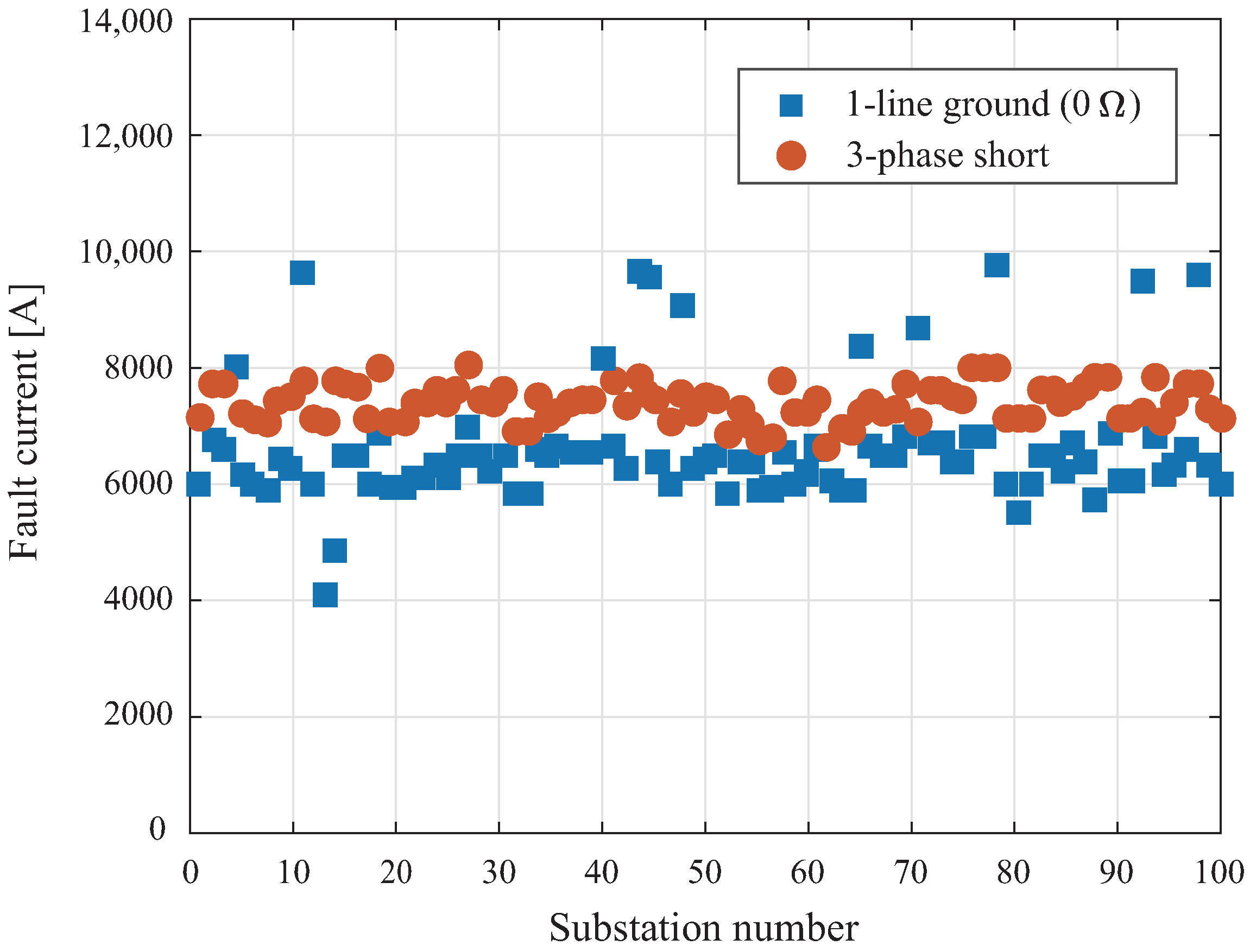
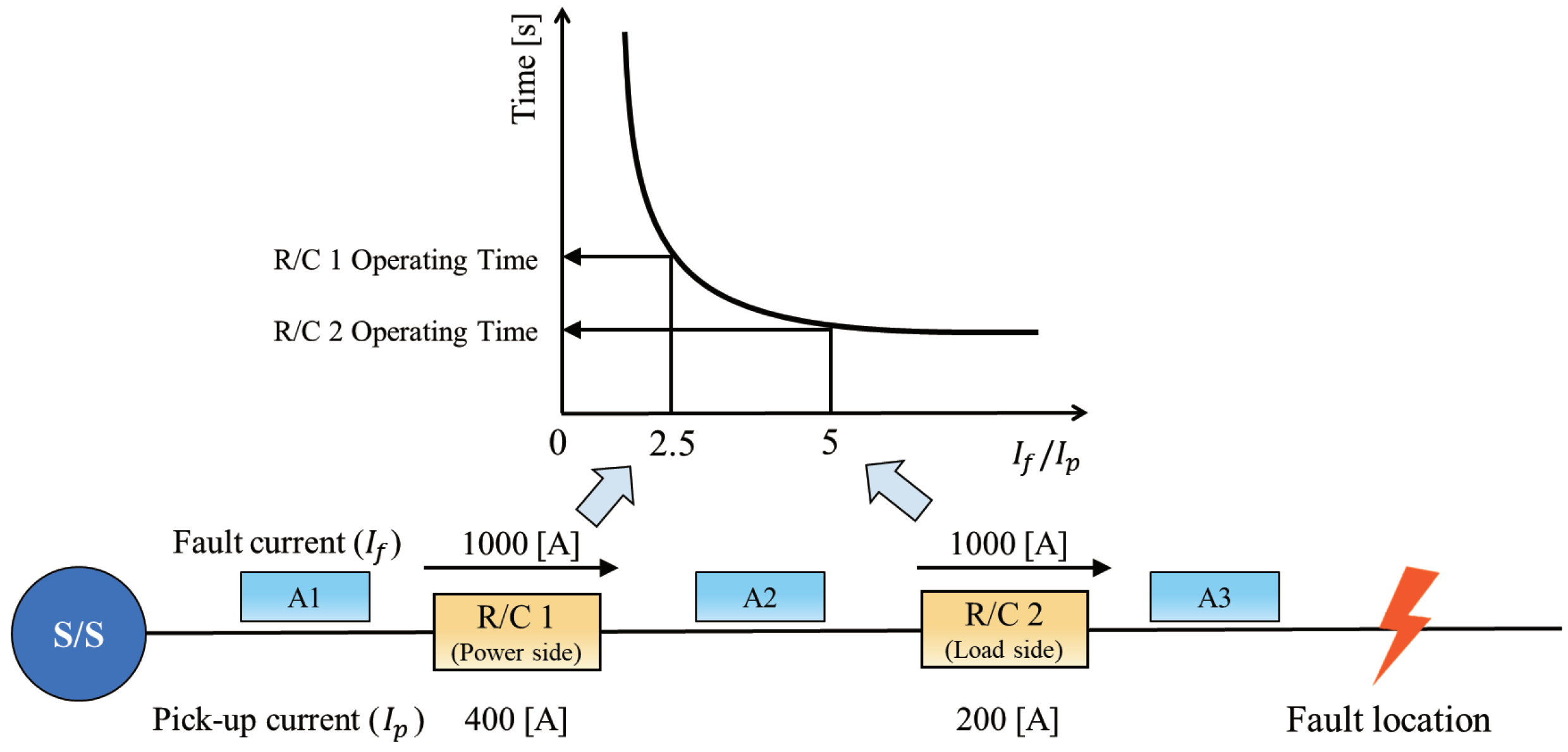

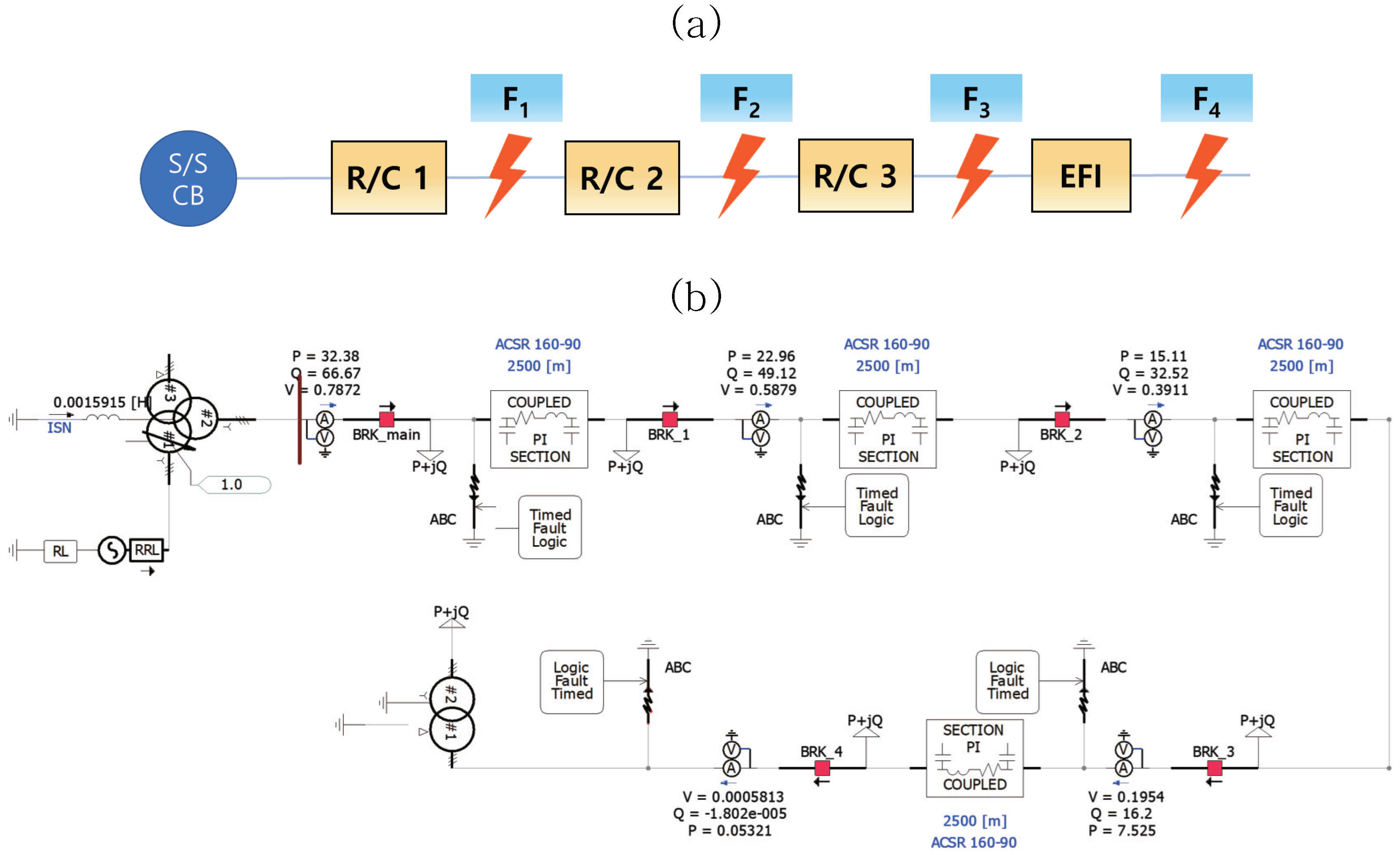
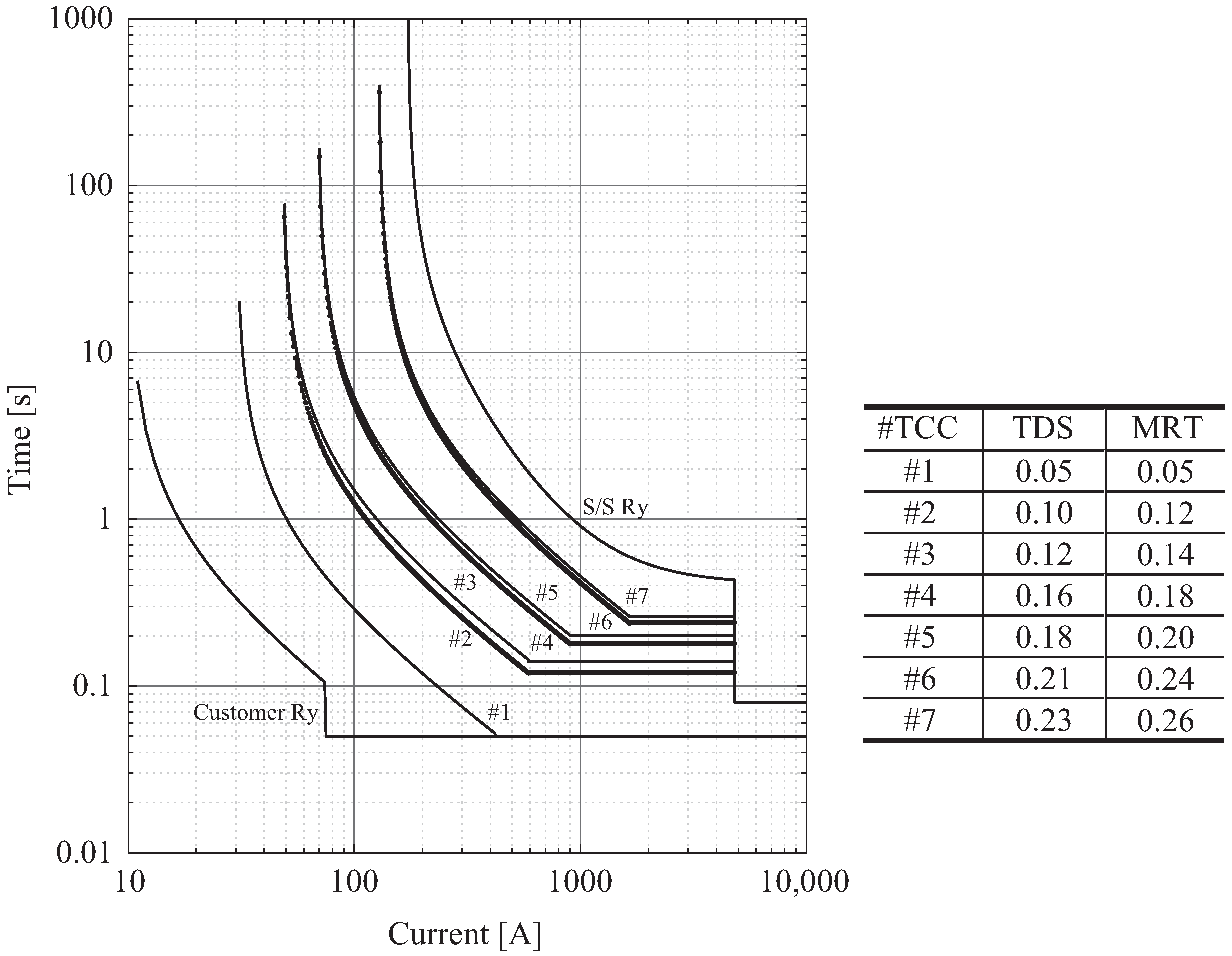
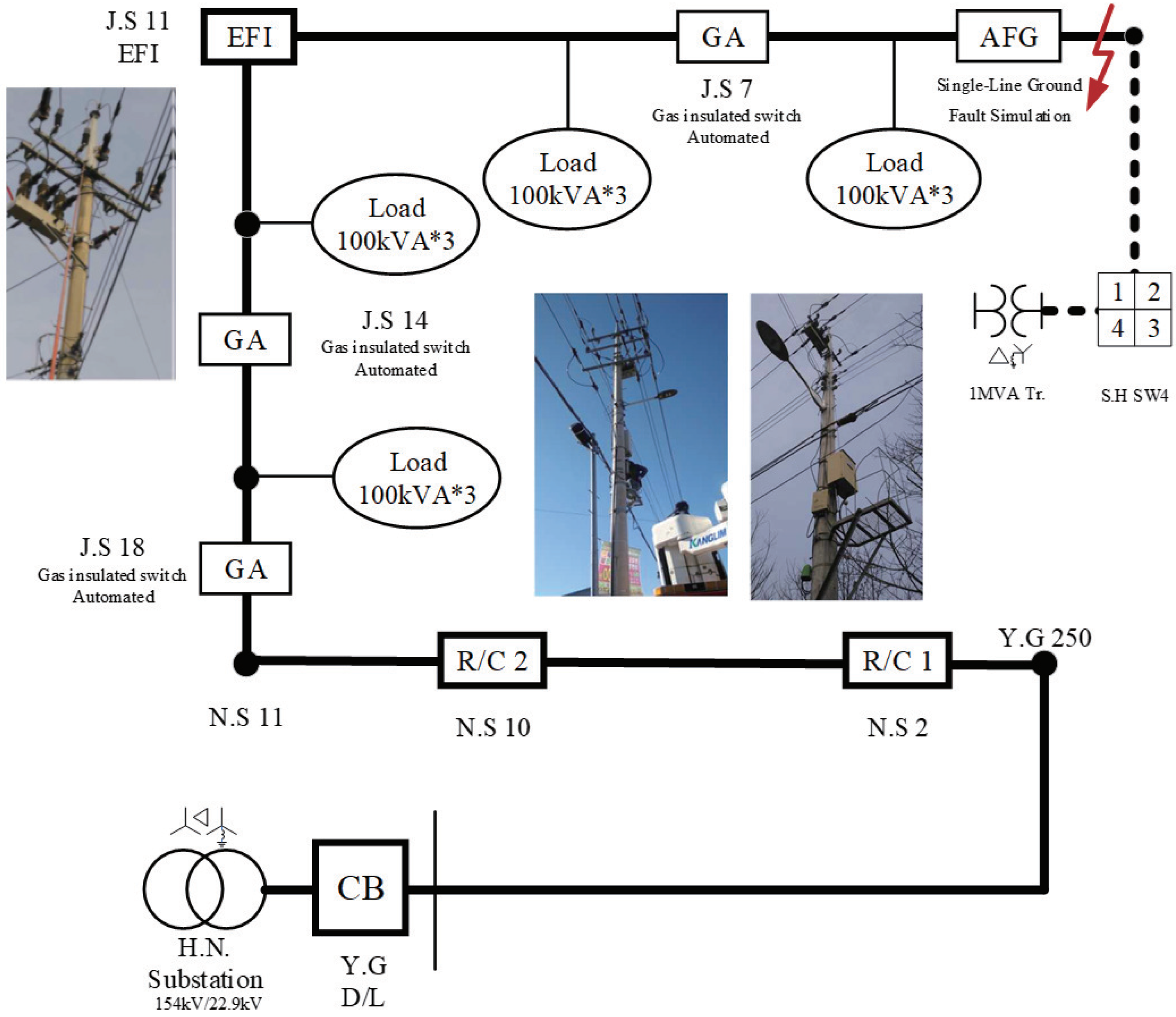
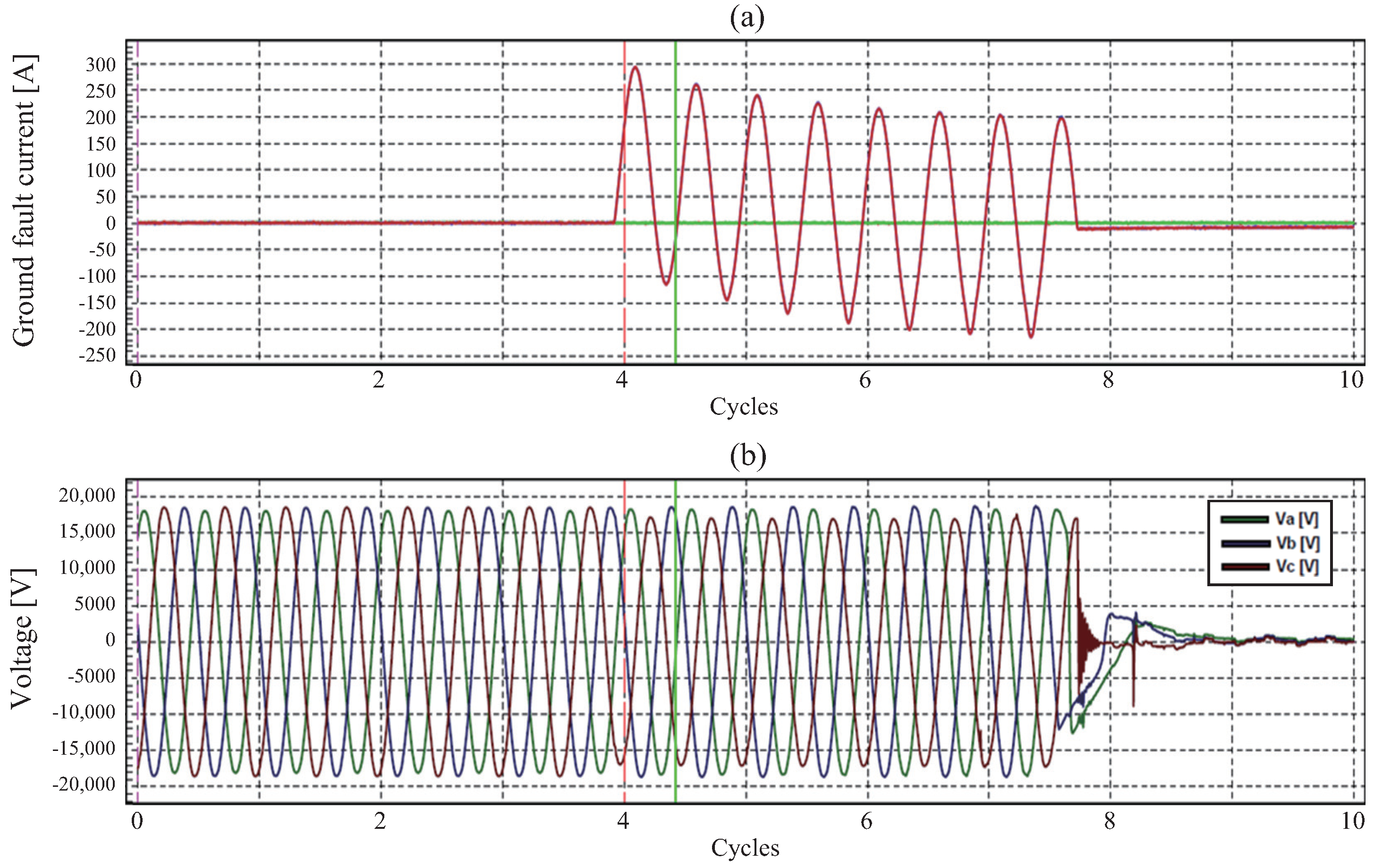
| Power Side Protective Device | Load Side Protective Device | CTI (Cycle) |
|---|---|---|
| Substation CB | Analog/Digital relay R/C | 10 |
| Analog relay R/C | Analog relay R/C | 3.5 |
| Analog relay R/C | Digital relay R/C | 3.5 |
| Digital relay R/C | Analog relay R/C | 3 |
| Digital relay R/C | Digital relay R/C | 3 |
| Analog relay R/C | EFI | 3.5 |
| Digital relay R/C | EFI | 3 |
| MCA | MCA | 3 |
| Relay Configuration | ||
|---|---|---|
| Time delayed Tap | OCR | Maximum operating current (352 A) × 1.5/CT ratio (600/5) = 4.41 A < Tap |
| OCGR | Maximum operating current (352 A) × 0.3/CT ratio (600/5) = 0.88 A < Tap | |
| Time delayed TDS | OCR | Blocking operation less than 0.5 s in case of three-phase short fault |
| OCGR | Blocking operation less than 0.5 s in case of single-line ground fault | |
| Type | MRT Setting | |||
|---|---|---|---|---|
| Four devices | R/C 1 | R/C 2 | R/C 3 | EFI |
| Fast | 0.24 | 0.18 | 0.12 | 0.05 |
| Delay | 0.26 | 0.20 | 0.14 | |
| Three devices | R/C 1 | R/C 2 | EFI | |
| Fast | 0.18 | 0.12 | 0.05 | |
| Delay | 0.20 | 0.14 | ||
| Two devices | R/C 1 | EFI | ||
| Fast | 0.12 | 0.05 | ||
| Delay | 0.14 | |||
| Curve Type | |||||
|---|---|---|---|---|---|
| Parameter | Short-Time Inverse | Standard Inverse | Very Inverse | Extremely Inverse | Long-Time Inverse |
| A | 0.04 | 0.14 | 13.5 | 80 | 120 |
| B | 0.04 | 0.02 | 1 | 2 | 1 |
| [p.u.] | [p.u.] | [p.u.] | |
|---|---|---|---|
| Source Impedance (@ 100 MVA) | 0.00105 + j0.01146 | 0.00527 + j0.029 | |
| CNCV/W Impedance (@ 100 MVA) | 0.01823 + j0.028222 | 0.053203 + j0.016495 | |
| ACSR Impedance (@ 100 MVA) | 0.034999 + j0.077498 | 0.086824 + j0.228644 | 0.091004 + j0.22841 |
| [p.u.] | [p.u.] | [p.u.] | |
| MTr Impedance (@ 60 MVA) | j0.14496 | j0.0669 | j0.2538 |
| Fault Type | CB Draw-Out | ||||
|---|---|---|---|---|---|
| Three-phase short circuit [A] | 7493 | 5683 | 3821 | 2880 | 2305 |
| Single-line ground circuit [A] | 4680 | 2278 | 1497 | 1110 | 878 |
| Type | CB Ry | R/C 1 | R/C 2 | R/C 3 | EFI | |
|---|---|---|---|---|---|---|
| Three-phase Short | Fast [A] | 540 | 430 | 290 | 220 | 184 |
| Delay [A] | 480 | 440 | 290 | 230 | 184 | |
| Single-line Ground | Fast [A] | 230 | 180 | 110 | 85 | 40 |
| Delay [A] | 220 | 175 | 114 | 88 | 40 | |
| Type | Condition | |
|---|---|---|
| 1 | Blocking operation time | IEC-VI curve: |
| 2 | Measurement error 5P20 | Rated (600 A) ±1%, up to 20 times (12,000 A) ±10% Within 6500 A of short-circuit fault/Within 5800 A of ground fault |
| 3 | difference between protective devices | Within 10∼20% |
| 4 | Substation TDS range | Short: above 3.78 Ground: above 4.0 |
| Objective function | Three-phase short circuit | Fast | 66.3050 + 66.5251 + 66.9925 + 3.5154 |
| Delay | 67.9763 + 66.5250 + 70.3019 + 3.5134 | ||
| Single-line ground fault | Fast | 69.4948 + 66.5250 + 70.3019 + 1.9332 | |
| Delay | 67.4037 + 66.7679 + 69.7456 + 1.9332 | ||
| Minimum CTI constraints | CB Ry-R/C: 167 ms (10 cycles) R/C-R/C: 58 ms (3.5 cycles) R/C-EFI: 58 ms (3.5 cycles) | ||
| Constraints | Three-phase short circuit | Fast | 33.8587 − 66.3050 ≥ 10 cycles 102.7131 − 66.5251 ≥ 3.5 cycles 90.6950 − 66.9925 ≥ 3.5 cycles 85.4676 − 3.5134 ≥ 3.5 cycles |
| Delay | 31.9402 − 67.9763 ≥ 10 cycles 105.4126 − 66.5250 ≥ 3.5 cycles 90.6950 − 70.3019 ≥ 3.5 cycles 89.7831 − 3.5134 ≥ 3.5 cycles | ||
| Single-line ground fault | Fast | 37.0764 − 69.4948 ≥ 10 cycles 110.7062 − 64.2394 ≥ 3.5 cycles 89.1000 − 67.1707 ≥ 3.5 cycles 86.8222 − 1.9332 ≥ 3.5 cycles | |
| Delay | 36.1484 − 67.4037 ≥ 10 cycles 107.2239 − 66.7679 ≥ 3.5 cycles 92.7108 − 69.7456 ≥ 3.5 cycles 90.2278 − 1.9332 ≥ 3.5 cycles | ||
| Common constraint | 0.10 ≤ ≤ 2.00, 0.01 step | ||
(R/C 1) | (R/C 2) | (R/C 3) | (EFI) | Optimal Value (Cycles) | ||
|---|---|---|---|---|---|---|
| Three-phase Short circuit | Fast | 0.2172 | 0.1623 | 0.1075 | 0.05 | 32.4 |
| Delay | 0.2295 | 0.1804 | 0.1195 | 36.0 | ||
| Single-line ground fault | Fast | 0.2072 | 0.1681 | 0.1072 | 32.4 | |
| Delay | 0.2314 | 0.1797 | 0.1204 | 36.0 | ||
| Four Devices | R/C 1 | R/C 2 | R/C 3 | EFI | |
| Fast | TDS | 0.21 | 0.16 | 0.10 | 0.05 |
| MRT | 0.24 | 0.18 | 0.12 | ||
| Delay | TDS | 0.23 | 0.18 | 0.12 | |
| MRT | 0.26 | 0.20 | 0.14 | ||
| Three Devices | R/C 1 | R/C2 | EFI | ||
| Fast | TDS | 0.16 | 0.10 | 0.05 | |
| MRT | 0.18 | 0.12 | |||
| Delay | TDS | 0.18 | 0.12 | ||
| MRT | 0.20 | 0.14 | |||
| Two Devices | R/C 1 | EFI | |||
| Fast | TDS | 0.10 | 0.05 | ||
| MRT | 0.12 | ||||
| Delay | TDS | 0.12 | |||
| MRT | 0.14 | ||||
| Three-phase short circuit | Pick-up current [A] | 384 | 345 | 276 | 220 | 184 |
| CTI Fast [ms] | 60 | 60 | 59 | |||
| CTI Delay [ms] | 179 | 60 | 60 | |||
| Single-line ground circuit | Pick-up current [A] | 84 | 75 | 60 | 48 | 40 |
| CTI Fast [ms] | 60 | 60 | 66 | |||
| CTI Delay [ms] | 176 | 60 | 60 |
| Pick-up current [A] | 384 | 345 | 276 | 220 | 184 |
| CTI Fast [ms] | 60 | 60 | 59 | ||
| CTI Delay [ms] | 179 | 60 | 60 |
| Fault Voltage [V] | Fault Current [A] | Breaker Operation | |||
|---|---|---|---|---|---|
| R/C 2 | EFI | ||||
| A | 13,277 | A | 0 | X | O |
| B | 13,440 | B | 0 | ||
| C | 12,981 | C | 146 | ||
| 3 | 119 | 3 | 146 | ||
Disclaimer/Publisher’s Note: The statements, opinions and data contained in all publications are solely those of the individual author(s) and contributor(s) and not of MDPI and/or the editor(s). MDPI and/or the editor(s) disclaim responsibility for any injury to people or property resulting from any ideas, methods, instructions or products referred to in the content. |
© 2023 by the authors. Licensee MDPI, Basel, Switzerland. This article is an open access article distributed under the terms and conditions of the Creative Commons Attribution (CC BY) license (https://creativecommons.org/licenses/by/4.0/).
Share and Cite
Kim, G.; Kim, W.-H.; Lee, C.-K. Selection of TCC Curve and Protection Cooperation Method of Distribution Line Using Linear Optimization. Electronics 2023, 12, 2705. https://doi.org/10.3390/electronics12122705
Kim G, Kim W-H, Lee C-K. Selection of TCC Curve and Protection Cooperation Method of Distribution Line Using Linear Optimization. Electronics. 2023; 12(12):2705. https://doi.org/10.3390/electronics12122705
Chicago/Turabian StyleKim, Geonho, Woo-Hyun Kim, and Chun-Kwon Lee. 2023. "Selection of TCC Curve and Protection Cooperation Method of Distribution Line Using Linear Optimization" Electronics 12, no. 12: 2705. https://doi.org/10.3390/electronics12122705





